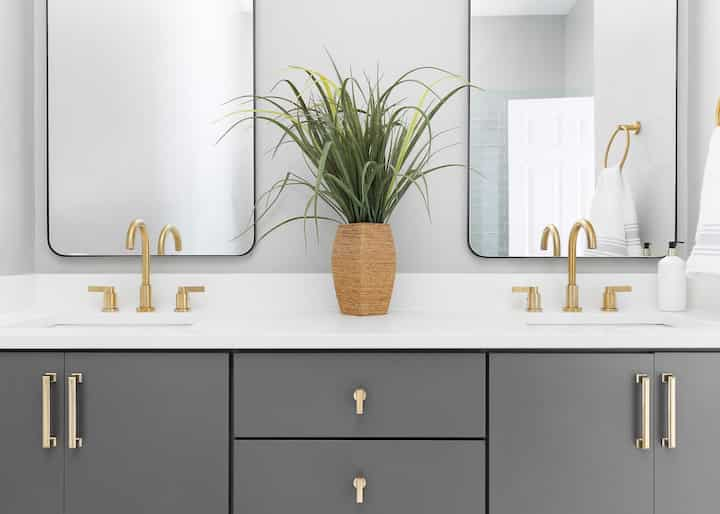
Selecting the right tile for your bathroom remodel
Bathroom remodels are exciting projects that can transform your home's most private space into a luxurious oasis. However, with so many tile options available, selecting the right one for your bathroom can be overwhelming. It is essential to consider various factors such as purpose, maintenance needs, and budget before making a decision.
Consider the purpose of the tile
In consideration of the purpose of the tile, it is imperative to choose a material that effectively addresses the functional demands of the bathroom space. One of the most critical factors to consider when selecting bathroom tiles is durability. Bathrooms are high traffic areas that are susceptible to moisture and humidity, which can cause wear and tear over time. Therefore, it is crucial to choose a tile material that can withstand daily use without breaking down or wearing out quickly.
Another essential factor to consider when selecting bathroom tiles is water resistance. Bathrooms are constantly exposed to water from showers, sinks, and toilets; hence, choosing a non-porous material such as ceramic or porcelain can be ideal for preventing water damage on walls and floors. Natural stone tiles like marble may look beautiful in bathrooms but require frequent sealing due to their porous nature, making them less ideal for areas prone to moisture buildup. By considering these functional demands when choosing bathroom tiles, homeowners can ensure they select materials that will stand up well over time while also enhancing the aesthetic appeal of their space.
Choosing between porcelain and ceramic tiles
When considering the type of tile to use for your bathroom remodel, it is important to compare the differences between porcelain and ceramic tiles. Both are popular options because they are durable, easy to clean, and come in a variety of colors and designs. However, there are some key differences that may impact your decision.
Porcelain tiles are made from finer clay than ceramic tiles and are fired at higher temperatures, making them denser and more durable. They have a water absorption rate of less than 0.5%, which makes them ideal for areas with high moisture, such as bathrooms or showers. Porcelain tiles also have a higher resistance to scratches and chips compared to their ceramic counterparts.
On the other hand, ceramic tiles tend to be less expensive than porcelain tiles but may not be as strong or long-lasting. They have a water absorption rate of over 0.5%, so they may not be suitable for wet areas unless properly treated with sealant.
Exploring natural stone tiles for a unique look
Natural stone tiles offer a distinctive and intriguing aesthetic for bathroom floors, walls, and showers. Made from natural materials such as marble, granite, travertine, and limestone, these tiles provide a unique texture and color that cannot be replicated by man-made materials. The variation in patterns and colors of natural stone tiles also means that no two pieces are alike, adding to the uniqueness of your bathroom remodel.
While natural stone tiles may require more maintenance than their ceramic or porcelain counterparts, they are incredibly durable and can last for decades if properly cared for. They also have a timeless elegance that can add value to your home. Some popular options include marble with its luxurious appearance, travertine with its rustic charm, or slate with its earthy feel. Whichever type of natural stone tile you choose for your bathroom renovation project will undoubtedly create a stunning focal point that is sure to impress anyone who enters the room.
Understanding maintenance needs
Maintenance needs for natural stone tiles are an important factor to consider when incorporating them into your bathroom design, as they require specific care to preserve their beauty and durability. Unlike other tile materials, natural stones such as marble, granite, and limestone are porous and absorbent. This means that they can easily be stained by acidic substances like vinegar or lemon juice if left on the surface for too long. To avoid this, it is recommended to clean up spills immediately using a pH-neutral cleaner.
Another essential aspect of maintaining natural stone tiles is sealing them regularly. Sealing helps protect the stone from staining and moisture damage by creating a protective layer on the surface. The frequency of sealing depends on the type of stone used and its level of porosity but generally should be done every 6-12 months. Proper maintenance practices can ensure that your natural stone tiles remain beautiful and functional for years to come while preserving their unique look in your bathroom remodel project.
Finding the perfect tile for your style and budget
Choosing the ideal tile for your bathroom redesign involves careful consideration of both your personal style and budget. With so many options available, it can be overwhelming to find the perfect balance between aesthetics and cost-effectiveness.
However, there are ways to narrow down your choices based on what you like and what you can afford. One way to start is by looking at inspiration photos or visiting showrooms to get a sense of the different types of tiles available. You may prefer a sleek and modern look, which could lead you towards larger format tiles with clean lines and minimal grout lines. On the other hand, if you're drawn towards a more traditional feel, ceramic subway tiles or mosaic patterns might be more up your alley.
From there, consider factors such as durability, slip-resistance (especially important in wet areas), maintenance needs, and overall cost when making your final decision. By taking these elements into account, you can find a tile that not only fits within your budget but also reflects your unique style. If you’re looking for bathroom tile services to complement your home, get in touch with our experienced professionals. Don’t wait – give our team a call today!